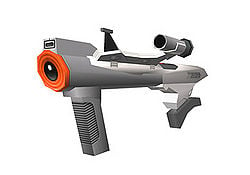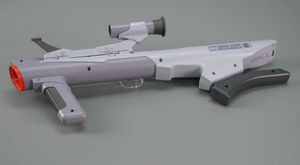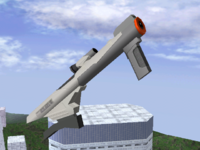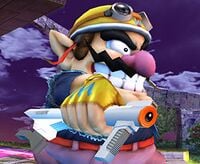Super Scope
| Super Scope | |
|---|---|
 The Super Scope | |
| Universe | Nintendo |
| Appears in | Melee Brawl |
| Item class | Shooting |
| Article on Super Mario Wiki | Super Scope |
The Super Scope, known as the Nintendo Scope in PAL regions (スーパースコープ, Sūpā Sukōpu) is a light-gun-style peripheral for the Super Nintendo Entertainment System. A wireless peripheral that could register shots in the game on the television screen by pointing at it and pressing buttons, the Super Scope was the successor to the NES Zapper peripheral, but its bulkier nature coupled with a lack of compatible SNES software ensured it was never successful commercially. It makes its appearances in Super Smash Bros. Melee and Super Smash Bros. Brawl as a battle item.
Origin
The Super Scope was released shortly after the Super NES system itself, released in September 1992 in the U.S. and European markets (the latter as the Nintendo Scope) primarily, with a limited Japanese release caused by little consumer demand. Bundled with the hardware was the software title Super Scope 6, and the full list of SNES games that featured compatibility with the peripheral numbered a notably low eleven: Battle Clash, Bazooka Blitzkrieg, The Hunt for Red October, Lamborghini American Challenge, Metal Combat: Falcon's Revenge, Operation Thunderbolt, Super Scope 6, T2: The Arcade Game, Tin Star, X-Zone, and Yoshi's Safari. In Melee and Brawl, the energy balls that come out of the super scope look similar to the energy balls in Confront in Super Scope 6. [1]
Item description
The Super Scope is a light gun-style peripheral that operated for the SNES much like its predecessor, the NES Zapper, operated for the original NES, and it only works with compatible games displayed on cathode ray tube monitors because it makes use of the monitor's display mechanics that involve a scanning electron beam and a photodiode. In light-gun games, you would aim the peripheral at an area of the television screen, pull the trigger, and the game would register where on the physical screen the peripheral was pointed using the cathode ray tube TV's behind-the-scenes mechanics. But whereas the Zapper is shaped like a large gun which is physically connected to the NES with a wire, the Super Scope is a much larger and heftier firearm resembling a vastly undersized bazooka, and it is wireless with a wireless receiver plugged into the SNES' controller slot and placed on top of the television to receive infrared communications from the Scope.
The Super Scope measures just under 2-and-a-half feet long, and it is powered by six AA batteries. It is held by gripping the six-inch handle at the peripheral's far end with the non-dominant arm, with the back end shaped to rest on the user's dominant shoulder, and the dominant arm is on the grey area on top of the lower half of the peripheral where three of the buttons on the scope are: the circular Fire button, the pill-shaped Pause button, and a sliding switch that turns the scope off, on, or on in Turbo mode. The fourth button is a "cursor" button on the grip handle itself, reachable by the non-dominant thumb. The Super Scope is designed to accommodate users of either dominant arm, which is why the scope's sight component is separate from and attachable to the bazooka on either side. If you're right handed, the sight is attached to the two left clips on the scope's front half so that your right eye can look through it, with your left hand gripping the front handle and the right hand on the buttons on top near your right shoulder, and vice versa. The model of the Super Scope as it appears in the Smash Bros. games faithfully preserves all of these aspects.
The Super Scope never achieved great critical or commercial success. Compared to its lightweight NES Zapper predecessor, it was panned by critics for its bulky nature which made it cumbersome to use, and the negative consumer feedback focused on the Super Scope's quick battery consumption; the six AA batteries could only last for four hours of continuous gameplay. The ultimate blow to the Super Scope came from a lack of software compatible with it, but it is hard to discern which of these caused the other: The Scope's unpopularity or the lack of software for it. Two videogame generations later, however, the Super Scope's spiritual likeness was inserted into the software titles Super Smash Bros. Melee and Super Smash Bros. Brawl as an in-game item, and it was subsequently popularized; it may be said that the game industry appreciated the Super Scope as an item in a successful videogame far more than as a tool for playing games. Since its Melee appearance the Super Scope has also cameoed in Mario & Luigi: Superstar Saga for Game Boy Advance as an item used by an enemy, and in WarioWare: Touched! for Nintendo DS. It also a similar looking copy called the Wii Zapper which mounts the Wii Remote and Nunchuk inline.
In Super Smash Bros. Melee
As an item
The Super Scope makes its primary appearance in the Smash Bros. series as a long-range shooting item in Melee. Like any other projectile weapon, when used for its effect the Super Scope restricts the character to being stationary. It can shoot a total of 48 small shots in rapid succession if the A button is pressed rapidly for about 7 seconds, and each shot is a moderately fast-moving-horizontally yellow orb that travels through an opponent and can hit multiple opponents, and each shot does either 0% or 1% damage with extremely little knockback, although a stream of them can have the effect of spiking an airborne opponent. If A is pressed sporadically and non-consecutively, each firing will fire a minimum of 3 shots in a row, and 16 such 3-round-bursts are possible.
What makes the item potentially powerful among projectiles is that each shot can be charged up by holding A down. When a shot is charged for any period of time, the resulting orb will become bigger, do more damage and knockback, disappear on contact, and more of the Scope's limited ammo is used up. The specifics of the resulting shot are proportional to the amount of time spent charging. The maximum amount of charging time allotted is roughly a full second, after which the charging Scope will automatically let loose its fully powered shot, which is a large yellow sphere of energy travelling faster than the smaller shots. The fully charged shot can deal anywhere between 15% and 28% damage, and deals a lot of knockback as well. It gradually gets less from 28% the more you shoot fully charged shots. The Super Scope has the ammo reserves to generate three fully-charged Super Scope shots, so 1 fully charged shot takes as much energy as 16 small shots.
The shots dissipate if they come into contact with a wall but can bounce off angled surfaces that are not particularly steep. The Super Scope, though its ammo is limited, can gain unlimited ammo through the Infinite Super Scope Glitch, and a spectacular glitch called the Black Hole Glitch involves infinite Super Scopes, a pair of Fox/Falcos, and Peach with her Turnips.
While some characters use the Super Scope as designed (Fox, Falco, Peach, Mario and Zelda), most characters don't look through the eyepiece, or hold the weapon with only one hand, or do something else entirely. Some characters have a slightly different firing speed as well.
As a trophy
The Super Scope features as a collectible trophy, unlocked as one of the 100+ trophies that can be collected randomly during normal play, such as in the Trophy Lottery and throughout the various Single-player Regular Matches. It reads as follows:
- Super Scope
- A peripheral device for the Super Nintendo Entertainment System, the Super Scope is a wireless weapon that shoots infrared light to a receiver placed on top of the television. In Super Smash Bros. Melee, it can be fired rapidly or charged up to release a more powerful blast. It only has enough energy for 3 charge shots. (Super Scope 9/92)
In Super Smash Bros. Brawl
The Super Scope returned in Brawl, with all of its features from the previous game intact, with the exception that uncharged shots no longer pass through opponents. The Super Scope, as with all other projectile weapons in the game, has received a universal modification, however: characters shooting with the Scope can freely move and jump about while in the act of shooting, no longer forced to remain stationary. Some characters can shoot the item faster when in the air, and some characters' shooting poses have been changed to allow them to walk and jump. There is a glitch that can be done involving Meta Knight's Final Smash, Galaxia Darkness and the Super Scope. If a character is shooting then gets stuck under the cape, it results in having the character go to a character model position.
A variant design is also wielded by the Scope Primid enemy in the Subspace Emissary. Unlike normal Super Scope items, the Primids can fire these versions vertically.
Damage Table
In Brawl, the momentum of a projectile will affect the damage a character will receive; these are recorded in bounces.
| Action | Template:G | Template:G | Template:G |
|---|---|---|---|
| Minimum falling speed | N/A | 4% | |
| Maximum falling speed | N/A | 11% | |
| Momentum collision bounce 1 | N/A | 10% | |
| Momentum collision bounce 2 | N/A | 7% | |
| Drop | N/A | 10% | |
| Forward tilt throw | N/A | 12% | |
| Up tilt throw | N/A | 13% | |
| Down tilt throw | N/A | 13% | |
| Dash throw | N/A | 14% | |
| Forward smash throw | N/A | 15% | |
| Up smash throw | N/A | 16% | |
| Down smash throw | N/A | 16% | |
| Aerial forward tilt throw | N/A | 12% | |
| Aerial up tilt throw | N/A | 13% | |
| Aerial down tilt throw | N/A | 14% | |
| Aerial forward smash throw | N/A | 12% | |
| Aerial up smash throw | N/A | 13% | |
| Aerial down smash throw | N/A | 14% |
Stages
These are the stages of damages and knockback for the Super Scope in Brawl. There are a total of eight stages with seven stages of charging and the fully charged stage, each stage increases the damage and knockback that the Super Scope does.
| Damage | Percent that can KO | |
|---|---|---|
| Stage 1 | 1% | Cannot KO |
| Stage 2 | 7% | 277% |
| Stage 3 | 10% | 226% |
| Stage 4 | 13% | 174% |
| Stage 5 | 16% | 148% |
| Stage 6 | 20% | 122% |
| Stage 7 | 24% | 99% |
| Stage 8 | 28% | 82% |
Description from the Super Smash Bros. Brawl instruction booklet
Fires small blasts and charged shots.
Trophy Description
A bazooka-shaped peripheral for the Super Nintendo Entertainment System that was used wirelessly with an infrared sensor placed on top of the television. In Smash Bros., it can be fired rapidly or charged up. In Super Smash Bros. Melee, you could not move while shooting it, but in this game, you can move and jump while blasting!
- Super Scope 6, 1992
Gallery
| Items in Super Smash Bros. Melee | |
|---|---|
| Normal | Barrel Cannon · Beam Sword · Bob-omb · Bunny Hood · Cloaking Device · Fan · Fire Flower · Flipper · Food · Freezie · Green Shell · Hammer · Heart Container · Home-Run Bat · Lip's Stick · Maxim Tomato · Metal Box · Motion-Sensor Bomb · Mr. Saturn · Parasol · Poison Mushroom · Poké Ball · Ray Gun · Red Shell · Screw Attack · Star Rod · Starman · Super Mushroom · Super Scope · Warp Star |
| Containers | Barrel · Capsule · Crate · Egg · Party Ball |
| Other | Smash Coins |
| Items in Super Smash Bros. Brawl | |
|---|---|
| Normal | Assist Trophy · Banana Peel · Beam Sword · Blast Box · Bob-omb · Bumper · Bunny Hood · Cracker Launcher · Deku Nut · Dragoon · Fan · Fire Flower · Food · Franklin Badge · Freezie · Golden Hammer · Gooey Bomb · Green Shell · Hammer · Heart Container · Home-Run Bat · Hothead · Lightning Bolt · Lip's Stick · Maxim Tomato · Metal Box · Motion-Sensor Bomb · Mr. Saturn · Pitfall · Poison Mushroom · Poké Ball · Ray Gun · Screw Attack · Smart Bomb · Smash Ball · Smoke Ball · Soccer Ball · Spring · Star Rod · Starman · Super Mushroom · Super Scope · Superspicy Curry · Team Healer · Timer · Unira · Warp Star |
| Containers | Barrel · Capsule · Crate · Party Ball · Sandbag · Rolling Crates |
| The Subspace Emissary |
Key · Stock Ball · Trophy Stand |
| Collectibles | CD · Coins · Sticker · Trophy |
| Other | Smash Coins and Bills |




